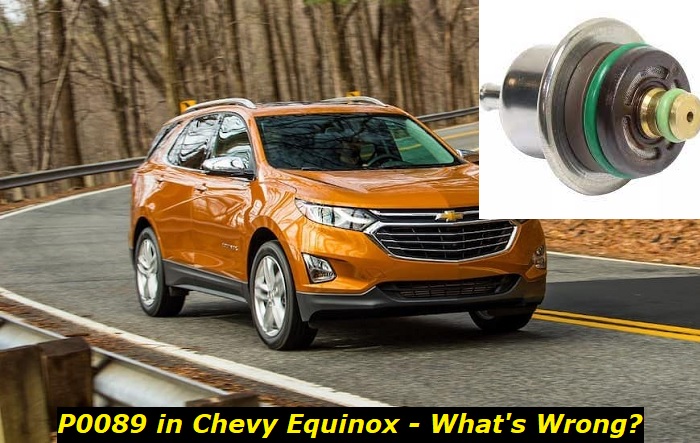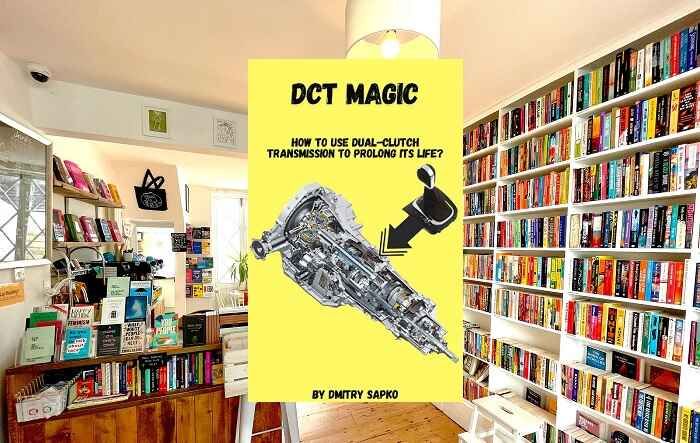The Chevy Equinox stays ahead of the pack in the compact SUV world due to its improved fuel economy, spacious and comfortable interior, and excellent drivability.
P0089 code highlights
- Level of urgency:High
- Possible culprits:fuel pump, fuel filter, fuel lines, fuel pressure sensor
- Price for repair:$100 - $800
- If neglected:Engine may not work efficiently, fuel pressure may fall evenfurther
- DIY repairs:Impossible
- Can you drive?Carefully

What does the P0089 Code Mean in Chevy Equinox?
The P0089 diagnostic trouble code(DTC) signifies a Fuel Pressure Regulator 1 problem. This means the fuel pressure regulator system isn't operating per the required standards. When the Electronic Control Unit(ECU) runs a check and finds that the fuel pressure is not meeting the expected values-through a varying signal voltage- it generates and stores the P0089 code. The ECU can detect varying pressures due to the fuel rail pressure sensor.
A resistance change affects the sensor terminals' voltage drop whenever the fuel pressure changes. The ECU can then receive the electrical signal that corresponds to the pressure. When there's a fuel pressure anomaly, the ECU generates a code.
The code then appears as a check engine warning light that illuminates the dashboard. This signals to the driver that there's an engine issue. To access the code, one has to use a diagnostic scanner tool to read and interpret it.
What are the Symptoms of the P0089 DTC in Chevy Equinox?
The P0089 code is associated with several symptoms. Apart from the check engine light on the dashboard, other common symptoms are:
- The engine unexpectedly stalls and becomes unreliable, which may lead to safety concerns.
- Intermittent engine misfires, which affect drivability and result in a decline in engine performance.
- Rough idling in which the engine vibrates, causing the car to shake while stationary.
- A decline in fuel economy.
- Appearance of other diagnostic trouble codes such as P00C6, P228D, and P228C.
What are the Causes of the P0089 Code in a Chevy Equinox?
The P0089 has several potential causes. The most common one is a faulty pressure regulator. However, this isn't always the case, and you should explore other possible causes of the trouble code.
Here are some of the most common possible causes:
1) Faulty Fuel Pressure Regulator
The fuel pressure regulator controls the fuel pressure that goes to the fuel injectors. It ensures the fuel injectors get a consistent pressure supply to facilitate different driving conditions. This means it has to supply fuel based on the vehicle's demands.
It has a diaphragm that receives vacuum pressure from one side and fuel pressure from the other. When the fuel pressure gets too low, it can affect the engine performance, making it slow or even not start. Conversely, if the fuel pressure becomes too high, it can result in engine misfires and high emissions.
To avoid fuel pressure getting too high, the fuel pressure regulator restricts the fuel flow, letting the fuel flow back to the fuel tank. When the regulator turns faulty, its spring weakens, and the diaphragm lets fuel pass through. Too-high or low fuel pressure can also lead to a decline in fuel economy and a reduced lifespan due to engine damage.
Other symptoms of faulty fuel pressure are:
- Engine sputtering.
- Discolored spark plug.
- Black smoke is coming off the exhaust.
- A gasoline smell from the dipstick.
- Backfires.
- Noise from fuel pump.
2) Clogged or Leaking Fuel Injector Nozzles
The fuel injectors deliver atomized fuel into the combustion chamber of an internal combustion engine. The injectors are attached to the fuel rail. When dirt, impurities, and carbon deposits accumulate in the fuel injectors, they can clog the nozzles which then fail to atomize and inject the fuel effectively. This is because they're stuck in a closed or open position.
The injectors may also leak due to the O-ring failure. You can find the O ring between the fuel rail and injectors. When the fuel leaks past the rings, it gets mixed up with the engine oil and causes it to thin. This affects its lubrication properties. Fuel leakage also reduces fuel pressure. This causes a little initial starting pressure, leading to a hard start.
Other symptoms of a clogged or leaking fuel injectors are:
- Rough idling.
- Misfiring engine
- Engine sputtering.
- Sporadic RPM needle.
- Poor fuel economy.
3) Blocked Fuel Filters
A blocked fuel filter can also create the P0089 trouble code. The fuel filter works to screen out any dirt, debris, and fuel contaminants present in the fuel. This is because if the foreign particles aren't strained out, they can damage crucial internal engine components, causing them to fail. It also allows the fuel to run smoothly inside the engine.
The fuel filter is located in the fuel line. A blocked fuel filter can cause an unnecessary strain on the fuel pump as it tries to compensate for delivering the right amount of fuel. Whenever the fuel filter is blocked, a reduction in fuel pressure and insufficient fuel reaching the combustion chambers causes the engine not to run optimally.
This makes the engine lose power during acceleration. Other symptoms of a blocked fuel filter include the engine stalling, misfiring, reduced fuel economy, and a fluctuating RPM needle.
4) A Malfunctioned Fuel Pump
A fuel pump relays fuel from the fuel tank to the engine. It also ensures there's high pressure in the fuel lines. The fuel pump may malfunction due to high heat, causing it to deliver inconsistent pressure to the engine. If the fuel pressure becomes too high or too low, the engine fails to work effectively. If the pressure is too high, the fuel runs rich. This is when too much fuel gets into the engine, affecting the air-fuel ratio.
When the fuel runs rich, you'll observe symptoms like high emissions, black smoke from the tailpipe, rough engine idling, and a strong gasoline smell. When the fuel runs lean due to low pressure, there's little fuel and a lot of air in the engine. This causes symptoms such as engine misfires, stalling, poor engine performance, and trouble starting the car.
5) Vacuum Leaks
Other important components that help maintain the required pressure in the engine are vacuum hoses. Vacuum lines are the smaller versions of vacuum hoses. The vacuum hoses relay vacuum power from the vacuum system throughout the vehicle. They also allow the correct combination of the fuel, air, and spark in an internal combustion engine at the right timing to produce sufficient engine power.
Vacuum power is transmitted to car components such as the exhaust gas recirculation(EGR) valve, heater control valve, vacuum brake booster, and vacuum advance. The vacuum hoses or vacuum lines are made of rubber or silicone. Like other car components, the vacuum hoses can wear out and cause leaks.
Excess air enters the engine whenever there's a vacuum leak, affecting the air-fuel mixture. This leads to a decreased vacuum compression that causes a decline in engine performance. Other vacuum leak symptoms are rough idling, hissing, or squealing sounds from the vacuum hoses, backfires, or black smoke from the exhaust.
How to Diagnose the P0089 Code in a Chevy Equinox
The first step in troubleshooting the P0089 DTC is to use a diagnostic scan tool to check and interpret the code and then erase and drive to see whether the codes will return after rescanning. Here are the steps to using the diagnosing tool.
- Plug in the scan tool to the OBD II port.
- Switch on the ignition and scan for the trouble codes.
- View and interpret the data while checking if multiple codes exist.
- Erase the trouble codes and drive to determine whether the check engine light and the trouble codes will return after scanning.
- As you drive, you can check the diagnostic tool to check the fuel pressure data and compare it to the manufacturer's specifications.
If the check engine light and the P0089 code return, the next step is to visually inspect the fuel components involved with fuel pressure. Start by inspecting the fuel pressure regulator for leakages and damage.
Conduct a fuel pressure test to check whether the fuel pressure is high or low. You can do this using a fuel pressure gauge. Connect the pressure gauge and run the pump to get the readings. Compare the values you get to the recommended fuel pressure of your car.
It would help if you also inspected the fuel injectors for any leaks or clogs that may affect the fuel pressure. The next component to check is the fuel filter, where you should check for clogging or buildup of dirt or debris.
How to Fix the P0089 Code in Chevy Equinox
Fixing the P0089 trouble code depends on what's causing it. Here are some fixes:
- If the issue lies with the fuel pressure regulator, replace it with a new one. Ensure you tightly screw the mounting bolts once you reconnect the fuel pressure regulator. Properly reinstall other components you had to remove to get to the pressure regulator.
- A clogged fuel injector needs cleaning to remove the buildup of foreign particles. There are a lot of fuel injector cleaners in the market. All you have to do is choose a quality one for effective cleaning. A leaky injector will need replacing.
- You'll need to replace a damaged fuel filter. This will require you to depressurize the fuel system before changing it to a new one. If your metal filter is dirty or clogged, you can remove it and clean it with a solvent cleaner.
- To solve a fuel pump issue, you can use a fuel system cleaner to clear any blockage due to debris.
Bottom Line
There you go-what the P0089 code in Chevy Equinox means, its causes, diagnosis, and ways to fix it. If you can't handle the diagnosis and fixing the code, it's best to leave it to a professional mechanic to do it for you.
About the authors
The CarAraC research team is composed of seasoned auto mechanics and automotive industry professionals, including individuals with advanced degrees and certifications in their field. Our team members boast prestigious credentials, reflecting their extensive knowledge and skills. These qualifications include: IMI: Institute of the Motor Industry, ASE-Certified Master Automobile Technicians; Coventry University, Graduate of MA in Automotive Journalism; Politecnico di Torino, Italy, MS Automotive Engineering; Ss. Cyril and Methodius University in Skopje, Mechanical University in Skopje; TOC Automotive College; DHA Suffa University, Department of Mechanical Engineering






Add comment